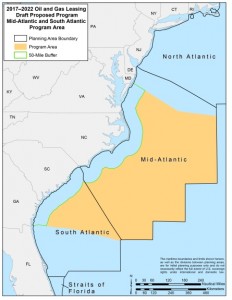Offshore Drilling Puts Fragile Virginia Coast at Risk
CAPE CHARLES WAVE
February 2, 2015
The Obama administration has announced plans to allow oil wells to be drilled off the coast of Virginia and several other southeastern states, with Virginia’s coastline placed at particular risk. Virginia Eastern Shorekeeper Jay Ford expressed “extreme disappointment” with the decision — “Potential spills would have devastating consequences for one of the most unique habitats on our planet. Our aquaculture industry, fisheries, tourism, and culture would all be put at risk,” he said.
 Veteran journalist Peter Galuszka, writing in Bacon’s Rebellion, provides the following commentary:
Veteran journalist Peter Galuszka, writing in Bacon’s Rebellion, provides the following commentary:
Almost five years after the infamous Deepwater Horizon disaster in the Gulf of Mexico, President Barack Obama has again proposed opening tracts offshore of Virginia and the southeastern U.S. coast to oil and natural gas drilling.
The plan poses big risks for what may be little gain. Federal surveys show there could be 3.3 billion barrels of crude oil and 31.3 trillion cubic feet of natural gas in the potential lease area stretching from Virginia to Georgia.
Energy industry officials praised the plan while complaining it doesn’t go far enough. Environmental groups including the Sierra Club and the Chesapeake Bay Foundation condemned it. Besides the ecological risk, the move is a step away from refocusing energy on renewables that do not lead to more carbon emissions and climate change.
(CONTINUED FROM FIRST PAGE)
Obama’s plan would restrict drilling to areas more than 50 miles off the coast. This is a sop to the Navy and other military which conduct regular exercises offshore and to the commercial and sports fishing industries.
Is the restriction worthwhile? It is generally easier for oil rigs to be placed in shallow water, and much of the areas off of Virginia and northeastern North Carolina and off of South Carolina and Georgia are in plateaus that aren’t very deep – maybe just a few hundred feet. Yet the Atlantic takes a huge plunge not far off of Cape Hatteras, descending as much as two miles down.
Drilling in deep water presents special problems for oil companies involving high pressure and high temperatures. That was the case with the Deepwater Horizon tragedy on April 20, 2010, that killed 11 workers. One big factor was that a blowout preventer, designed to shut down the rig if drilling hits abnormally high levels of pressure, didn’t work completely. The rig was in 5,000 feet of water, and crude spewed uncontrolled. Winds from the south washed the oil towards land and polluted nearly 500 miles of coastline in Florida, Alabama, Mississippi, and Louisiana. An estimated 49 million barrels of crude were released.
Although it isn’t certain if energy firms would drill in the very deep waters off of North Carolina, there is cold comfort in the fact that the Deepwater rig was only 48 miles from shore. In other words, it would have been too close in for the latest plan involving the southeastern coast. Supposedly, blowout preventers have been upgraded, but there were still spills involving them off of Brazil and China post-Deepwater.
If something like that happened closer to home, it is not exactly certain where the oil would go. Winds can blow from the ocean, and currents are very fickle. The Labrador Current might tend to push spilled oil back onto environmentally sensitive shoreline while the Gulf Stream might tend to take the spilled oil out to sea.
There is no question that drilling off any of the southeastern coast would be of some benefit to the now-struggling Tidewater economy since it has plenty of steel-bending industries, an able workforce, and no significant bridges to pass under to reach deep water. It might help since the defense sector is winding down, but who knows what world conflicts will be like in 2025. Hampton Roads would be a more logical staging area than other ports such as Wilmington, N.C., Charleston, or Savannah.
There’s a rub, however. The 3.3 billion barrels of estimated reserves isn’t that much. It is a fraction of the total estimated reserves in the country. Energy sector officials claim there is probably much more. Okay, fine, but no one knows for sure. The natural gas reserves involved are also somewhat small – just a fraction of the estimated reserves in the U.S.
It’s not the first time offshore drilling has come up locally. There was a big push for it in the late 1970s, prompting oil rig giant Brown & Root to buy up land near Cape Charles for fabricating rigs. Nothing happened and much of the land now is used for a luxury golf community. Obama was supposed to back lease sales in 2010 but then Deepwater happened. This begs the question – if the offshore petroleum is so valuable, why has it taken so long?
Yet another issue is what cut Virginia would actually get from offshore drilling. There was a flap a few years ago when offshore drilling was being pitched. Some revenues to states from offshore petroleum production are computed by how much shoreline a state has. In Virginia’s case, it is not much, at least when compared to North Carolina. Virginia politicians have pointed this out and hope for some adjustment.
No one can predict energy markets a decade from now. For instance, no one knew that hydraulic fracturing would increase petroleum production by 64 percent and possibly make the United States a petroleum exporter for the first time since the 1970s. Granted, it is a rock-and-a-hard-place kind of choice. Fracking is fraught with pollution problems just as offshore drilling is.
There are certain to be plenty of lawsuits over the offshore plan,, and economics will likely determine its future. An important choice is whether it is worth risking Virginia’s military, resort and fishing businesses for Big Oil, whose promise is uncertain when it comes to offshore drilling.




















Comments